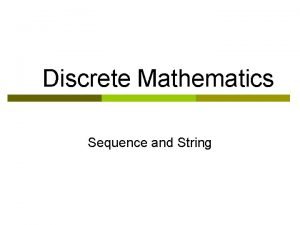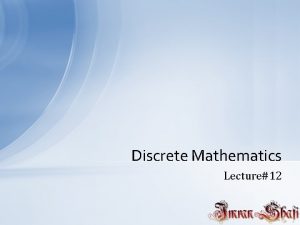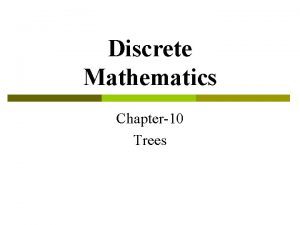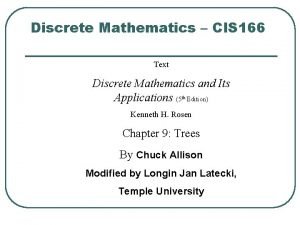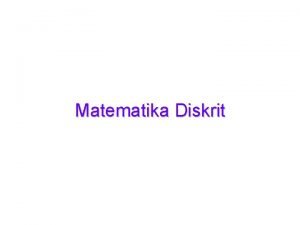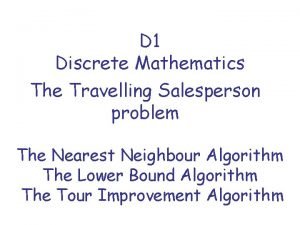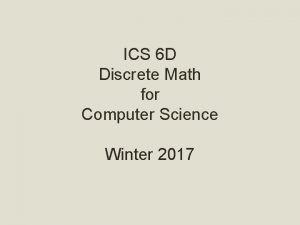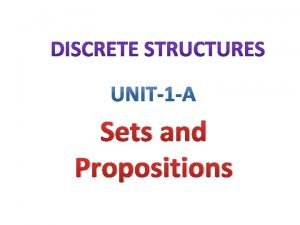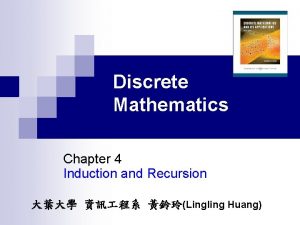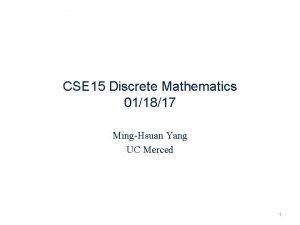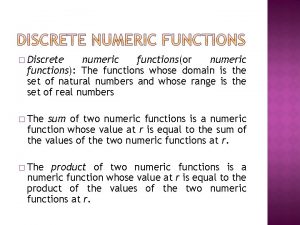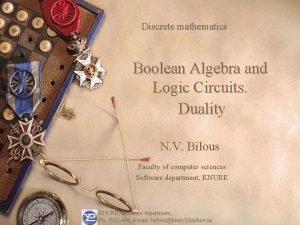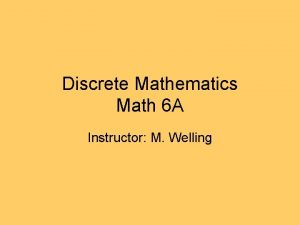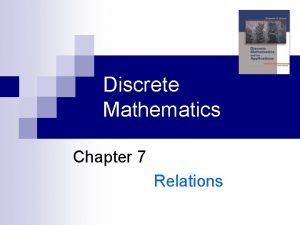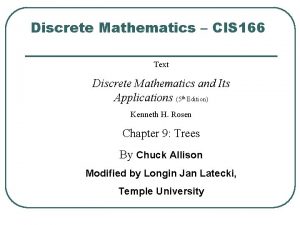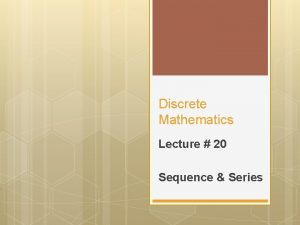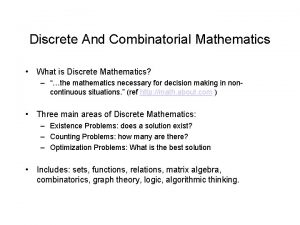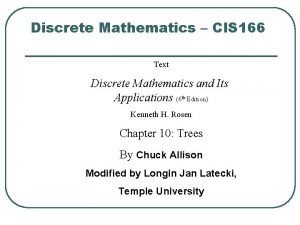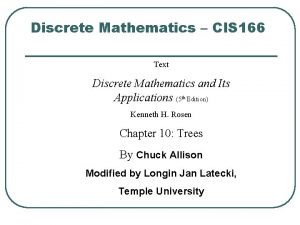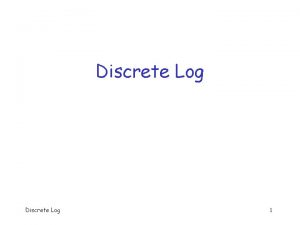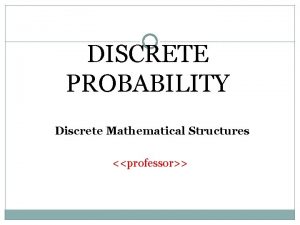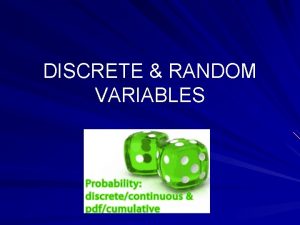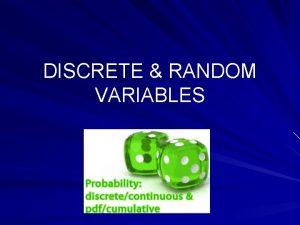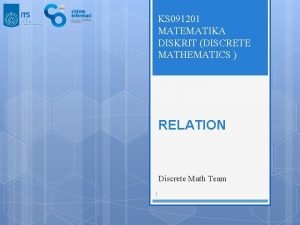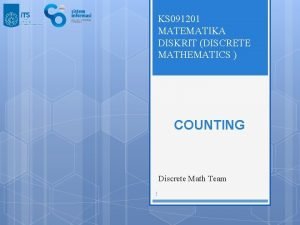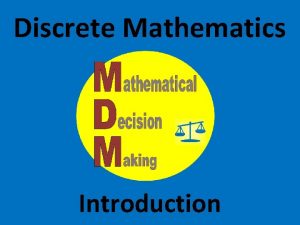Discrete Mathematics Lecture14 Sequence A sequence is just


















- Slides: 18

Discrete Mathematics Lecture#14

Sequence A sequence is just a list of elements usually written in a row. EXAMPLES ü 1, 2, 3, 4, 5, … ü 4, 8, 12, 16, 20, … ü 2, 4, 8, 16, 32, … ü 1, 1/2, 1/3, 1/4, 1/5, … ü 1, 4, 9, 16, 25, … ü 1, -1, … NOTE: The symbol “…” is called ellipsis, and reads “and so forth”

Sequence: Formal Definition A sequence is a function whose domain is the set of integers greater than or equal to a particular integer n 0. Usually this set is the set of Natural numbers {1, 2, 3, …} or the set of whole numbers {0, 1, 2, 3, …}.

Sequence: Notation NOTATION We use the notation an to denote the image of the integer n, and call it a term of the sequence. Thus a 1, a 2, a 3, a 4, …, an represent the terms of a sequence defined on the set of natural numbers N. Note that a sequence is described by listing the terms of the sequence in order of increasing subscripts.

Sequence with explicit Formula An explicit formula or general formula for a sequence is a rule that shows how the values of ak depends on k. Example: Define a sequence a 1, a 2, a 3, … by the explicit formula

Defining Sequence: Example Write the first four terms of the sequence defined by the formula aj = 1 + 2 j, for all integers j 0 Note: The formula aj = 1 + 2 j, for all integers j 0 defines an infinite sequence having infinite number of values

Defining Sequence: Example Compute the first six terms of the sequence defined by the formula an = 1+ (-1)n for all integers n 0 Note: 1. If n is even, then an = 2 and if n is odd, then an = 0 Hence, the sequence oscillates endlessly between 2 and 0. 2. An infinite sequence may have only a finite number of values

Defining Sequence: Example Find explicit formulas for sequences with the initial terms given: 0, 1, -2, 3, -4, 5, … 2, 6, 12, 20, 30, 42, 56, … 1/4, 2/9, 3/16, 4/25, 5/36, 6/49, …

Arithmetic Sequence A sequence in which every term after the first is obtained from the preceding term by adding a constant number is called an arithmetic sequence or arithmetic progression (A. P. ) The constant number, being the difference of any two consecutive terms is called the common difference of A. P. , commonly denoted by “d”. EXAMPLES 1. 5, 9, 13, 17, … (common difference = 4) 2. 0, -5, -10, -15, … (common difference = -5) 3. x + a, x + 3 a, x + 5 a, … (common difference = 2 a)

Generic Form of Arithmetic Progression Let a be the first term and d be the common difference of an arithmetic sequence. Then the sequence is a, a+d, a+2 d, a+3 d, … an = a + (n - 1)d for all integers n 1 In above formula; an is nth term, n is number of term, a is first term of progression and d is common difference

Arithmetic Progression: Example Find the 20 th term of the arithmetic sequence 3, 9, 15, 21, …

Arithmetic Progression: Example Which term of the arithmetic sequence 4, 1, -2, …, is -77?

Arithmetic Progression: Example Find the 36 th term of the arithmetic sequence whose 3 rd term is 7 and 8 th term is 17.

Geometric Sequence A sequence in which every term after the first is obtained from the preceding term by multiplying it with a constant number is called a geometric sequence or geometric progression (G. P. ) The constant number, being the ratio of any two consecutive terms is called the common ratio of the G. P. commonly denoted by “r”. EXAMPLES 1, 2, 4, 8, 16, … (common ratio = 2) 3, - 3/2, 3/4, - 3/8, … (common ratio = - 1/2) 0. 1, 0. 001, 0. 0001, … (common ratio = 1/10)

Generic Form of Geometric Progression Let a be the first tem and r be the common ratio of a geometric sequence. Then the sequence is a, ar 2, ar 3, … If ai, for i 1 represent the terms of the sequence, then a 1 = first term = ar 1 -1 a 2 = second term = ar 2 -1 a 3 = third term = ar 2 = ar 3 -1 ……………… an = nth term = arn-1; for all integers n 1

Geometric Progression: Example Find the 8 th term of the following geometric sequence 4, 12, 36, 108, …

Geometric Progression: Example Which term of the geometric sequence is 1/8 if the first term is 4 and common ratio ½?

Geometric Progression: Example Write the geometric sequence with positive terms whose second term is 9 and fourth term is 1.
 Sequence discrete math
Sequence discrete math Transitive relation
Transitive relation What is rooted tree in discrete mathematics
What is rooted tree in discrete mathematics M ary tree in discrete mathematics
M ary tree in discrete mathematics Kenneth rosen discrete mathematics solutions
Kenneth rosen discrete mathematics solutions Travelling salesman problem discrete mathematics
Travelling salesman problem discrete mathematics Zybook
Zybook Sets and propositions
Sets and propositions Induction and recursion discrete mathematics
Induction and recursion discrete mathematics Boolean functions in discrete mathematics
Boolean functions in discrete mathematics Discrete mathematics
Discrete mathematics Discrete numeric functions
Discrete numeric functions Tree traversal in discrete mathematics
Tree traversal in discrete mathematics Law of duality in discrete mathematics
Law of duality in discrete mathematics Basics of counting in discrete mathematics
Basics of counting in discrete mathematics Mathematical proposition
Mathematical proposition Symmetric relation
Symmetric relation M ary tree in discrete mathematics
M ary tree in discrete mathematics Application of propositional logic
Application of propositional logic
